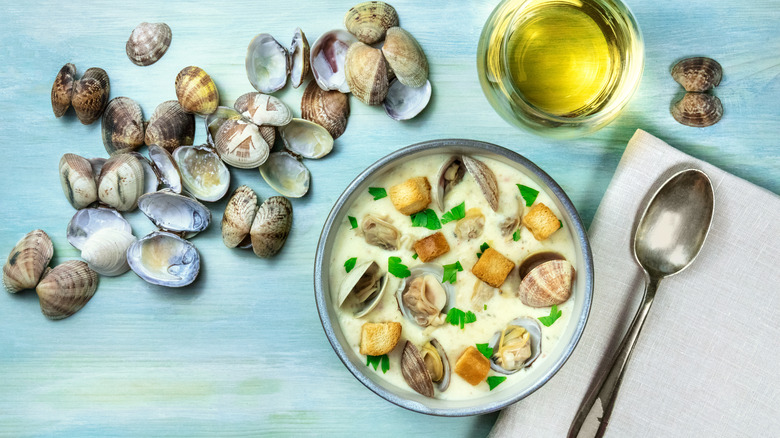The Strange Ingredient Traditionally Used To Thicken Bisque
Nothing warms like a good soup, especially a nice bisque. A glorious creation from our friends across the sea, bisque is a thick, creamy seafood stew brought to us by those most time-honored of foodies: the French. Though considered something of an elegance today, the origins of bisque are very humble in nature. The name of a food is very much attached to its history, and there are two prevailing theories of how bisque got its name, according to Taste Atlas. The first theory is phonetic in nature, referring to the French bis cuits meaning a soup that is cooked twice; The second theory postulates a relation of bisque to the Bay of Biscay, owing to the use of the stew's spicer ingredients being found in the area.
Regardless, food historians believe that the name shares a strong connection with the sea, as bisque was first mentioned in the 17th century, likely as a fisherman's soup. The French boatmen would reportedly make bisque using whatever shellfish they could find: shrimp, crab, and even lobster. Bisque is, by nature, a very thick soup. And to achieve the thickness required of the broth, fishermen used the leftovers they had at their disposal, which often were shells (via ForknPlate).
Crushed shells make thick bisques
Bisque derives its intense savory flavor from a seafood stock. The standard way to do this is to separate the shells from the meat and fire roast them. Then, you sauté onions, celery, and carrots in butter until they're soft before adding the shells, some water, sherry or brandy, spices, and a bay leaf and simmering the mixture down to a rich stock (per ForknPlate). This gets you the flavorful base for your stew and thickens the broth.
In the traditional, or authentic, way of making bisque, the shells are removed from the bubbling broth and set aside. Then, the both is strained twice and returned to the stock pot. The leftover shells are then ground down to a paste and used, along with cream, to thicken the bisque to its signature, velvety texture (via The Spruce Eats). Other thickening techniques, such as using rice or a roux – a concoction of flour and butter — are far more common in today's cooking and are the preferred way of thickening most bisques.
However, should you find yourself someday overburdened with crustaceans and extra time, perhaps give the traditional method a go.

